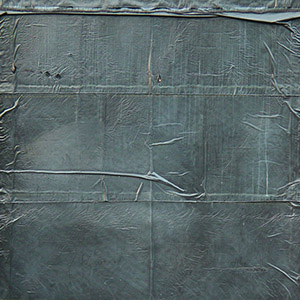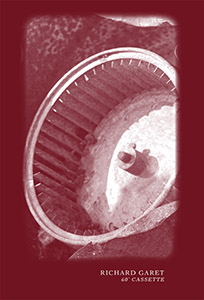Richard Garet, "Meta", "60' Cassette"
 These two recent releases from Garet both showcase drastically different styles and compositional methods. Meta, a single 52 minute piece derived from a four channel installation, does an excellent job of conveying the original’s work of physical space. The other, 60' Cassette, is exactly what it sounds like: an hour long work derived completely from magnetic tape in various states of disarray. Even though the work represents two extremes, Garet's adeptness as an artist and composer results in two significantly different, but equally wonderful works.
These two recent releases from Garet both showcase drastically different styles and compositional methods. Meta, a single 52 minute piece derived from a four channel installation, does an excellent job of conveying the original’s work of physical space. The other, 60' Cassette, is exactly what it sounds like: an hour long work derived completely from magnetic tape in various states of disarray. Even though the work represents two extremes, Garet's adeptness as an artist and composer results in two significantly different, but equally wonderful works.
Meta's initial intent and construction was to draw out everyday, mundane background noises and place the focus on them.The original installation encouraged movement between the four sound sources, and to experience the sounds directly, as well as through objects and from a more significant distance.Of course being mixed down to a stereo CD hinders the original artistic vision, but Garet does an admirable job at capturing the dynamic shifts and evolutions into this format.
Unsurprisingly then, much of Meta is made up of quiet, distant vibrations, subtle noises, occasional buzzing, and at times abrasive scraping.Given its conceptual nature, he conjures images of buzzing florescent lights, loose air conditioning ducts and humming vehicles in the distance.Some passages sound as if they are coming from the ultrasonic spectrum:vibrations that are seemingly less heard and more felt, both at extreme high and low frequencies.As a whole it has a grey, concrete and steel feeling to it and despite its non-intrusive nature, it never becomes forgettable or easily ignored.
samples:

While Meta is defined largely by its use of space and quiet, 60' Cassette is as direct and blunt as its title would insinuate.The first side of the tape immediately begins with loud textures built from sputtering motors and crackling magnetic tape.White static rapids crash throughout as the occasional fragments of what sounds like voice or whatever was previously recorded on an erased tape slip through walls of decay and interference.Garet mangles his magnetic source material into passages of crackling wood or heavy rain, constantly moving and never standing still.
The second half of the tape lightens up on the crunch (though some drastic crashes and bangs cut through at the onset) and instead puts a focus on tone and space.Wet bursts, buzzing bees, and patterns of noise break up moments of tonal shimmering.As the piece goes on, Garet generates echoing, cavernous space teeming with ambiguity, and later into frigid, windswept tundra.
Between Meta's construction from the mundane and the everyday into a largely hushed, quiet electronic composition and 60' Cassette’s forceful and violent sounds of decay and deconstruction, Richard Garet captures two distinctly different extremes in the world of sound art.Perhaps most impressive then is the fact that he tackles the dichotomy so brilliantly, with both being exceptional in their diversity and quality.While my personal bias may lean more towards that analog crunch that is all over the cassette release, the cold purity of Meta is no less exceptional.
samples:
 



